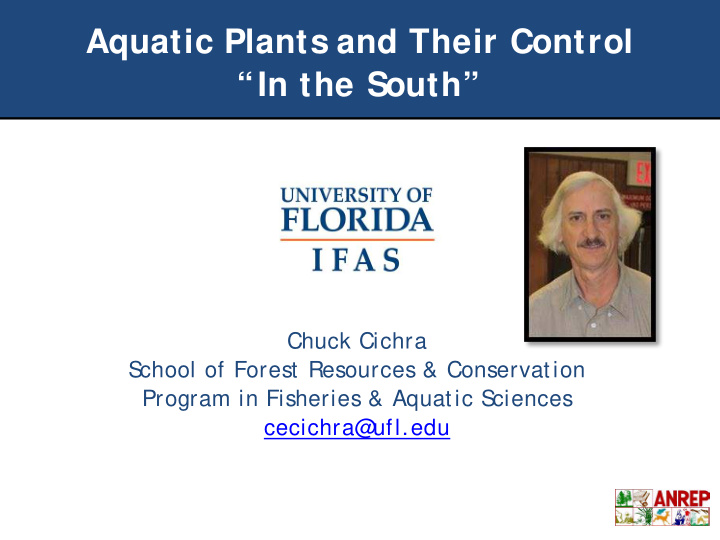



Aquatic Plants and Their Control “In the South” Chuck Cichra S chool of Forest Resources & Conservation Program in Fisheries & Aquatic S ciences cecichra@ ufl.edu
Overview of Talk ● Bryan has done an excellent j ob of summarizing aquatic plant biology and control! ● Nutrients / eutrophication / fertilization ● When do plants become weeds (expectations) ● Integrated plant management ● Herbicide active ingredients vs trade names ● Herbicide toxicities ● Aquatic weeds in southern ponds ● Managing livestock to reduce weed problems in ponds
All Plants Need Water, Light, and Nutrients
Aquatic Plants are No Different
Algae and Phytoplankton are Small Plants
Amount of Chlorophyll (algae) in the Water is Closely Related to the Amount of Nitrogen and Phosphorus in the Water Data from 60 Florida Lakes
Water clarity vs ‘Algae’
Fertilization – Purposeful Addition of Nutrients to the Water
Fish blocknet data on 60 Florida lakes 250 200 Blocknet Total Fish (kg/ha) 150 100 50 0 Oligotrophic Mesotrophic Eutrophic Hypereutrophic Trophic State (chlorophyll)
Clear to Green! Add fertilizer! “Shade out the macrophytes” I personally don’t recommend fertilizing
Given time, macrophytes will also increase in abundance!
When do plants become weeds? Depends on our goals for the water body our expectations “ Beauty is in the eye of the beholder!”
Expectations of Ponds ( plants - lots to none ) • Water treatment – Settling of particulates – Dissolved nutrient removal • Aesthetics • Wildlife habitat • Wetland Mitigation • Fishing (20-30%) • Boating • Water hazards • Livestock watering • Flood control • Irrigation • Swimming
Let’s talk about Aquatic Weed Control – We’ve come a long way!
Methods Used to Control Aquatic Weeds Hand removal / Harvesting Grass carp Pond dyes Herbicides (Nutrient removal)
DON’T WANT THIS!
Most People Believe Toxins Cause Most Fish Kills
Herbicides registered for aquatic use
Aquatic Herbicide Toxicity (ppm)
Turf and Ornamental Irrigation Restrictions - Read the Label!
What are Some of the Common Weeds in the South?
Planktonic Algae Single cells • Suspended in water • “Green water” •
Filamentous Algae
Floating Plants
Duckweeds
Watermeal Proper ID!
Mosquito fern Fire Ant Control!
Water Hyacinth Look Nice: But! 1 Plant = 1 Acre in 1 Year!
Water Lettuce Possibly Exotic
Emergent Plants
Cattails
Dollarweed or Penneywort (Hydrocotyl)
Torpedograss ( exotic )
Opposite leaves Alligatorweed Scaly flowers Root at nodes Hollow stems
Alligatorweed Exotic Biocontrol!
Primrose Willow
Floating-Leaved Plants
Water Shield (a.k.a. – Snot Bonnet )
Fragrant Water Lilly
Spatterdock / Cow Lilly / Bonnets
Submergent Plants
Southern Naiad
Coontail
Parrot Feather
Bladderwort Carnivorous!
Hydrilla Hydrilla Exotic
What herbicide is ‘best’ for control? Effectiveness of Herbicide Active Ingredients for Aquatic Weed Control Endothall 2,4-D Glyph Ima- Tri- Carfentra Diqu Coppe Fluri- Penox- Imaza- Hydrogen o- zapy clopy - Hydrotho Granul Liqui at r 1 done 2 sulam 2 mox peroxide Aquathol sate r r zone l ar d FLOATING Duckweed * * G * F * E * * * * E * * Watermeal * * * * * * F * * * F G * * Water fern * * E * * * E * * * E E * * Mosquito fern * * E * * * E * * * E E * * Water hyacinth * * E * E F * G E E F E E * Water lettuce * * E * * F * F E * E E G * Frog's bit * * E * * * * * E F * E E * Alligatorweed * * * * F * * G E G * F E * Also, submersed, emersed, and algae Source: Efficacy of Herbicide Active Ingredients Against Aquatic Weeds K. Langeland, M. Netherland, and W. Haller (http://edis.ifas.ufl.edu/ag262)
Livestock and Ponds Nutrient source Bank erosion Increase turbidity Create shallow areas
What if the pond is needed to water livestock? Fence the pond off from livestock and provide a small area for livestock to access the water – add gravel to slow erosion
What if the pond is needed to water livestock? Use stock tank with either gravity-fed or solar powered water-level control valve (fence pond) Check your local US DA-NRCS office for cost sharing
Questions? • Please complete the webinar evaluation: http:/ / bit.ly/ PondMgt • To learn more about ANREP visit our website at: www.anrep.org • You can watch the archived version of this webinar at: http:/ / www.anrep.org/ resources/ anrep-webinars/ Thank you!
Recommend
More recommend